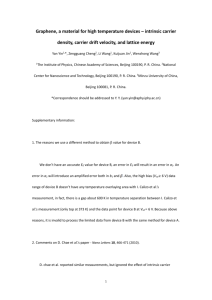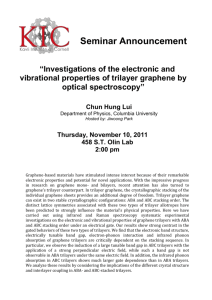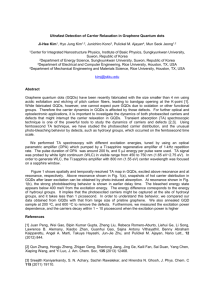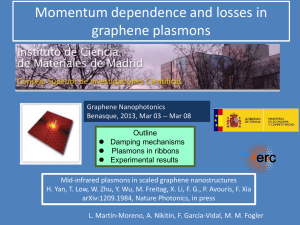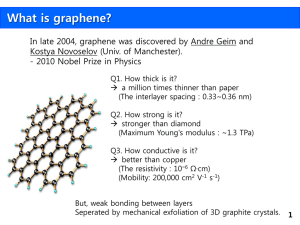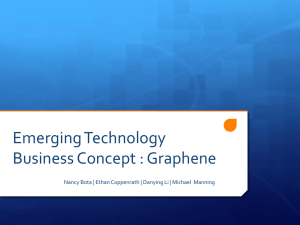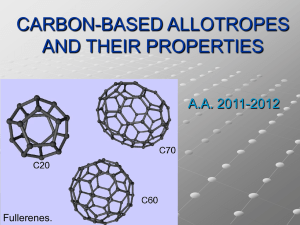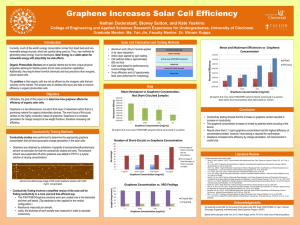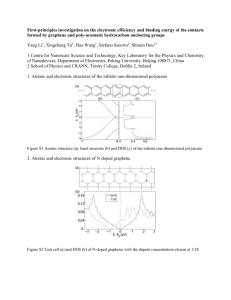PowerPoint-Präsentation
advertisement
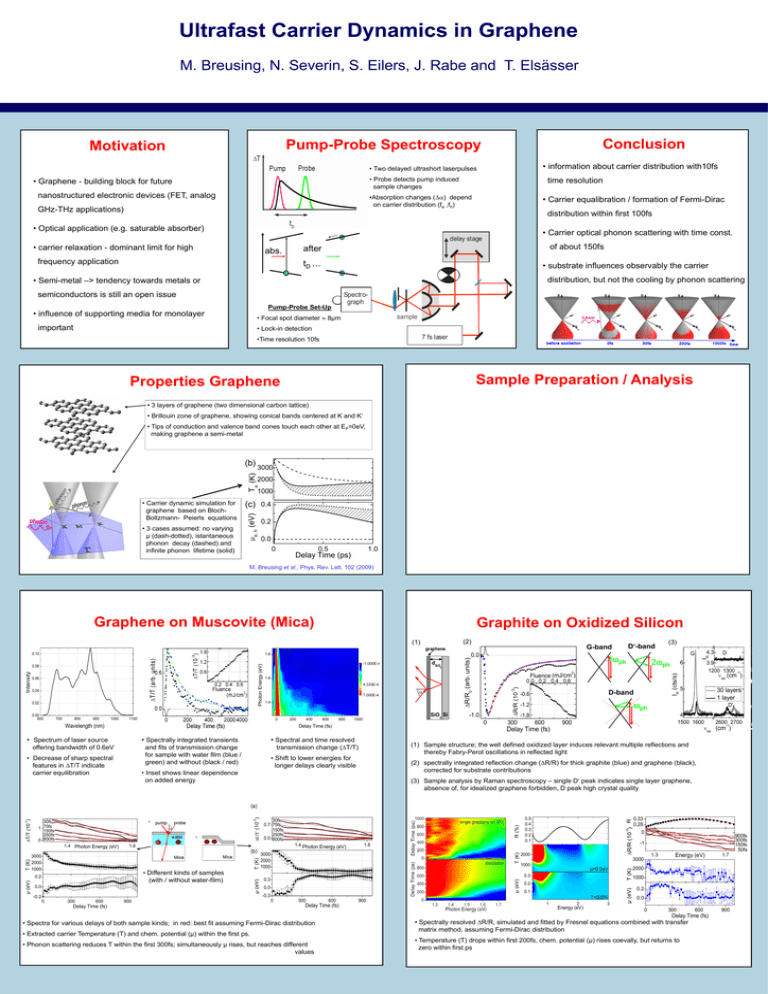
Ultrafast Carrier Dynamics in Graphene M. Breusing, N. Severin, S. Eilers, J. Rabe and T. Elsässer Conclusion Pump-Probe Spectroscopy Motivation • information about carrier distribution with10fs • Two delayed ultrashort laserpulses • Probe detects pump induced sample changes • Graphene - building block for future nanostructured electronic devices (FET, analog time resolution •Absorption changes () depend on carrier distribution (fe ,fh) GHz-THz applications) • Carrier equalibration / formation of Fermi-Dirac distribution within first 100fs • Optical application (e.g. saturable absorber) • Carrier optical phonon scattering with time const. delay stage • carrier relaxation - dominant limit for high of about 150fs after abs. frequency application tD … • Semi-metal –> tendency towards metals or • substrate influences observably the carrier distribution, but not the cooling by phonon scattering 0 ( f h f e ) semiconductors is still an open issue Spectrograph Pump-Probe Set-Up • influence of supporting media for monolayer • Focal spot diameter 8µm important sample • Lock-in detection 7 fs laser •Time resolution 10fs Sample Preparation / Analysis Properties Graphene 0.4 e, h (eV) (a) carbon lattice) • 3 layers of graphene (two dimensional 3000 Te (K) • Brillouin zone of graphene, showing conical bands centered at K and K‘ 2000 • Tips of conduction and valence band cones touch each other at EF=0eV, 1000 making graphene a semi-metal 0 0.5 0.0 1.0 Delay Time (ps) 3000 Te (K) (b) 2000 1000 • 3 cases assumed: no varying µ (dash-dotted), istantaneous phonon decay (dashed) and infinite phonon lifetime (solid) (c) 0.4 e, h (eV) • Carrier dynamic simulation for graphene based on BlochBoltzmann- Peierls equations 0.2 0.0 0 0.5 1.0 Delay Time (ps) graphene M. Breusing et al., Phys. Rev. Lett. 102 (2009) dSiO 2 Graphene on Muscovite (Mica) Graphite onSiO Oxidized Silicon Si 2 1100 0 Wavelength (nm) 200 400 600 800 SiO2 Si 1000 Delay Time (fs) offering bandwidth of 0.6eV • Spectral and time resolved and fits of transmission change for sample with water film (blue / green) and without (black / red) • Decrease of sharp spectral features in T/T indicate carrier equilibration • Shift to lower energies for longer delays clearly visible 0 • Different kinds of samples µ (eV) 0.2 (with / without water-film) 0.0 -0.2 0 300 600 Delay Time (fs) 900 600 Delay Time (fs) 0.3 0.0 300 600 Delay Time (fs) • Spectra for various delays of both sample kinds; in red: best fit assuming Fermi-Dirac distribution • Extracted carrier Temperature (T) and chem. potential (µ) within the first ps. • Phonon scattering reduces T within the first 300fs; simultaneously µ rises, but reaches different values 900 1.3 20µm 1.5 (eV) Energy 900 (a) 0.5 0.4 0.3 0.2 0.1 2000 (b) 1000 µ=0.0eV 0.3 0 IR (cts/s) -1 (3) Sample analysis by Raman spectroscopy – single D‘ peak indicates single layer graphene, -1.8 absence of, for idealized graphene forbidden, D peak high crystal quality 1.8 3000 2000 1000 -0.3 300 -1.2 R (%) 30fs 0.7 75fs 150fs 250fs 0.0 800fs 1.4 Photon Energy (eV) 900 1 (2) spectrally integrated reflection change (R/R) for thick graphite (blue) and graphene (black), -0.6 corrected for substrate contributions 0 T (K) 3000 2000 1000 (b) T (K) T (K) (b) 1.8 µ (eV) 1.4 Photon Energy (eV) Delay Time (fs) µ (eV) / (10 ) -3 -3 T/T (10 ) (a) 30fs 1 75fs 150fs 250fs 0 800fs 4 1500 1600 2600 2700 -1 (cm ) rel (c) 0.0 0.2 0.4 0.6 -1.0 (a) 600 30 layers (1) Sample structure; the well defined oxidized layer induces relevant multiple reflections and 0.28 2 thereby (mJ/cm )Fabry-Perot oscillations in reflected light Fluence 0.23 transmission change (T/T) • Inset shows linear dependence on added energy 30 layers 1 layer D' -1.8 300 5 R • Spectrally integrated transients 0 3.9 1200 1300 -1 1 layer rel (cm ) wph -1.2 2 laye 0.33 R/R0 (arb. units) • Spectrum of laser source 0.0 -1.0 -0.6 6 (b) D -3 1000 D-band 4.3 G R/R (10 ) 900 1.4 0.0 0.2 0.4 0.6 -3 R/R (10 ) R 800 7.000E-4 -3 700 R/R (10 ) 0.00 600 4.333E-4 2 0.2 0.1 T=500K 1 2 Energy (eV) 3 0.33 0.28 0 -1 1.3 3000 T (K) 0.02 1.6 (a) 2wph Fluence (mJ/cm ) µ (eV) 0.04 2 wph -3 0.06 dSiO -1.000E-4 R/R (10 ) Photon Energy (eV) 0.08 Intensity 0.0 1.8 R/R0 (arb. units) 0.10 D‘-band G-band graphene (3) IR (2) (1) Energy (eV) 1.7 2000 1000 0.2 0.0 0 300 600 Delay Time (fs) • Spectrally resolved R/R, simulated and fitted by Fresnel equations combined with transfer matrix method, assuming Fermi-Dirac distribution • Temperature (T) drops within first 200fs, chem. potential (µ) rises coevally, but returns to zero within first ps 900 900fs 300fs 150fs 50fs 1.7
